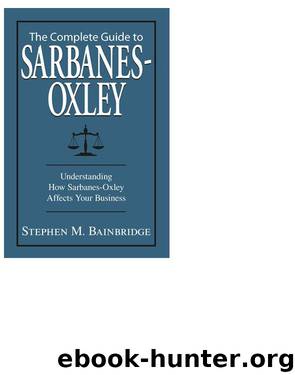The Complete Guide to SARBANES-OXLEY by STEPHEN M. BAINBRIDGE;

Author:STEPHEN M. BAINBRIDGE;
Language: eng
Format: epub
Tags: epub, ebook
Publisher: Stephen M. Bainbridge
Published: 2007-07-15T00:00:00+00:00
6
Board Committees and Proper Corporate Governance
Virtually all states allow the board to establish committees to which some board powers may be delegated, although a number do so only on an opt-in basis pursuant to which committee formation must be authorized by the articles of incorporation or bylaws. Section 141(c)(2) of the Delaware General Corporation Law, for example, provides that the board may set up one or more committees consisting of one or more members. The jurisdiction and powers of the committee must be specified either in the bylaws or in the board resolution creating the committee. All of the powers and authority of the board may be delegated to such committees, except that board committees are barred from acting on matters requiring shareholder approval or changes to the bylaws.
The NYSE Listed Company Manual mandates the establishment of three committees: a nominating and corporate governance committee (§ 303A.04), a compensation committee (§ 303A.05), and an audit committee (§ 303A.06). NASDAQ only requires establishment of an audit committee (as we'll see below, SOX required all the stock exchanges to adopt a mandatory audit committee rule).
The continuing proliferation of board committees is one reason boards are getting bigger. For a long time, there had been a trend toward smaller boards, with seven members having become typical. Most observers praised this trend, because smaller boards tend to work more effectively. With the additional required committees and all the additional duties being piled on committee members by SOX and the stock exchange requirements, however, the trend has reversed and boards are getting bigger again. Apparently, extra bodies are needed so that no one director ends up being overloaded with committee assignments and homework. Because size matters, the result may be less effective decision making by the board as a whole.
The Nominating and Corporate Governance Committee
NYSE Listed Company Manual § 303A.04 requires that listed companies set up “a nominating/corporate governance committee composed entirely of independent directors.” The committee must have a written charter specifying how it will go about identifying candidates for board membership and selecting those candidates to be nominated. The committee should have sole power to select headhunters and negotiate their fees.
NASDAQ gives companies an alternative. Under Marketplace Rule 4350(c), new directors must be nominated either by a majority of the independent directors or a nominating committee comprised solely of independent directors.
The nominating power is vitally important. Board-of-director elections usually look a lot like old Soviet elections — there is only one slate of candidates and the authorities know how each voter voted. Absent the very unusual case of a proxy contest, in which a dissenting shareholder puts forward an alternative slate of director candidates, the slate nominated by the outgoing board of directors will be re-elected by default.
Corporate reformers long complained that boards simply rubber stamped the CEOs choices. In theory, having a separate committee of independent directors who are in charge of the nomination process should weaken the CEO's grip on power.
EXEMPTION FOR CONTROLLED COMPANIES
Both the NYSE and NASDAQ exempt companies in
Download
This site does not store any files on its server. We only index and link to content provided by other sites. Please contact the content providers to delete copyright contents if any and email us, we'll remove relevant links or contents immediately.
Hit Refresh by Satya Nadella(9041)
The Compound Effect by Darren Hardy(8820)
Change Your Questions, Change Your Life by Marilee Adams(7640)
Nudge - Improving Decisions about Health, Wealth, and Happiness by Thaler Sunstein(7622)
The Black Swan by Nassim Nicholas Taleb(7016)
Deep Work by Cal Newport(6888)
Daring Greatly by Brene Brown(6451)
Rich Dad Poor Dad by Robert T. Kiyosaki(6414)
Principles: Life and Work by Ray Dalio(6227)
Playing to Win_ How Strategy Really Works by A.G. Lafley & Roger L. Martin(5939)
Man-made Catastrophes and Risk Information Concealment by Dmitry Chernov & Didier Sornette(5926)
Digital Minimalism by Cal Newport;(5669)
Big Magic: Creative Living Beyond Fear by Elizabeth Gilbert(5616)
The Myth of the Strong Leader by Archie Brown(5429)
The Slight Edge by Jeff Olson(5353)
Discipline Equals Freedom by Jocko Willink(5291)
The Motivation Myth by Jeff Haden(5158)
Stone's Rules by Roger Stone(5027)
The Laws of Human Nature by Robert Greene(5004)
